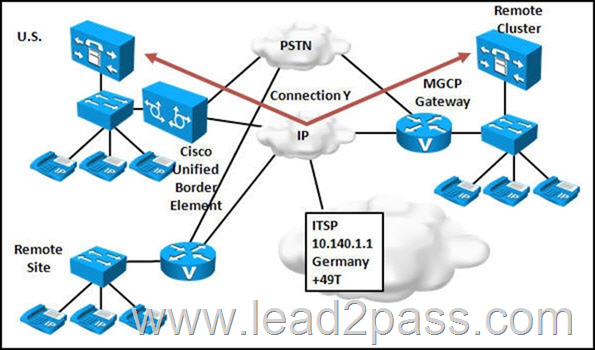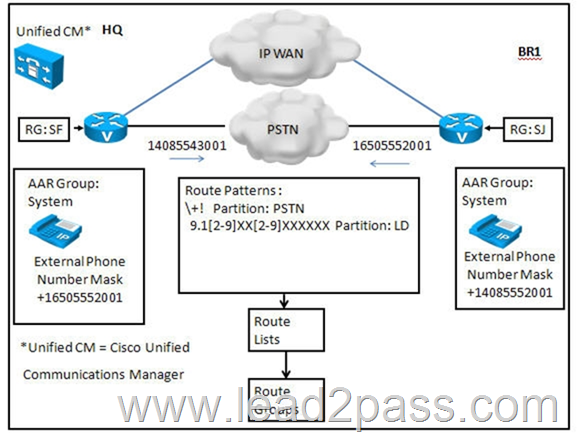2016 November Cisco Official New Released 300-075 Dumps in Lead2pass.com!
100% Free Download! 100% Pass Guaranteed!
No doubt that 300-075 exam is a worth challenging task but you should not feel hesitant against the confronting difficulties. Lead2pass is supplying the new version of 300-075 VCE dumps now. Get a complete hold on 300-075 exam syllabus through Lead2pass and boost up your skills. What’s more, the 300-075 dumps are the latest. It would be great helpful to your 300-075 exam.
Following questions and answers are all new published by Cisco Official Exam Center: http://www.lead2pass.com/300-075.html
QUESTION 181
Which option configures call preservation for H.323-based SRST mode?
A. voice service voip h323 call preserve
B. call preservation not possible with H.323
C. call-manager-fallback preserve-call
D. dial-peer voice 1 voip call preserve
Answer: A
QUESTION 182
Which configuration command disables the secondary dial tone on the branch office ISR for users calling from the PSTN into the branch office during a WAN failure?
A. direct-inward-dial
B. voice translation-rule
C. incoming called-number
D. application
Answer: A
QUESTION 183
A Cisco Unified Communications Manager cluster is installed in headquarters only.
How can international calls be blocked while national calls are allowed for branch office Cisco IP Phones during a WAN failure?
A. Configure CSS and partitions in Cisco Unified Communications Manager and apply the CSS and partitions to the SRST ISR.
B. Configure CSS and partitions in the SRST ISR.
C. Configure COR in the SRST ISR.
D. Configure voice translations in the SRST ISR.
Answer: C
QUESTION 184
Which command can be used to manually send the MGCP gateway to register with the secondary Cisco Unified Communications Manager server?
A. ccm-manager switchover-to-backup
B. mgcp use backup
C. ccm-manager register backup
D. not supported
Answer: A
QUESTION 185
This is the configuration on the voice gateway:
telephony-service
max-ephones 30
max-dn 60 preference 0
srst mode auto-provision all
srst dn line-mode dual
srst dn template 3
srst ephone description srst fallback auto-provision phone
srst ephone template 5
Which ephone-dn would be expected upon activation of SRST?
A. ephone-dn 1 dual-line
number 7001
description 7001
name 7001
ephone-dn-template 5
This DN is learned from srst fallback ephones
B. ephone-dn 1 dual-line
number 7001
description 7001
name 7001
ephone-dn-template 3
This DN is learned from srst fallback ephones
C. ephone-dn 1
number 7001
description 7001
name 7001
ephone-dn-template 5
This DN is learned from srst fallback ephones
D. ephone-dn 1
number 7001
description 7001
name 7001
ephone-dn-template 3
This DN is learned from srst fallback ephones
Answer: A
QUESTION 186
Which ability does the Survivable Remote Site Telephony feature provide?
A. a means to allow the local site to continue to send and receive calls in the event of a WAN failure
B. a means to route calls on-net through other sites during high utilization periods
C. a method that allows for backup calls in the event that your gateway fails
D. the ability to force a call out of a certain trunk when the Cisco Unified Communications Manager is being upgraded
Answer: A
QUESTION 187
What component acts as a user agent for both ends of a SIP call while Cisco Unified SIP SRST is providing failover during a WAN outage?
A. B2BUA
B. SIP server
C. SIP proxy
D. SIP SRST router
E. SIP registrar
Answer: A
QUESTION 188
Which two configurations are needed to implement SRST in Cisco Unified Communications Manager? (Choose two.)
A. SRST Gateway setting in Cisco Unified Communications Manager
B. SRST Reference configured in Cisco Unified Communications Manager
C. Device Pool SRST Reference setting
D. Call Manager Group setting
E. Cisco Unified Communications Locations setting
Answer: BC
QUESTION 189
Which of the following are two functions that ensure that the telephony capabilities stay operational in the remote location Cisco Unified SRST router? (Choose two)
A. Automatically detecting a failure in the network.
B. Initiating a process to provide call-processing backup redundancy.
C. Notifying the administrator of an issue for manual intervention.
D. Proactively repairing issues in the voice network.
Answer: AB
QUESTION 190
Which three of the following are steps in configuring MGCP Fallback and Cisco Unified SRST? (Choose three)
A. Define the SRST reference for phones in the Device Pool configuration
B. Enable and configure the MGCP fallback and Cisco Unified SRST features on the IOS gateways.
C. Implement a simplified SRST dial plan on the remote-site-gateways to ensure connectivity for remote-site phones in SRST mode.
D. Enable SIP trunking between both remote and hub sites to provide mesh coverage.
E. Define the SRST reference in the configuration on the IP Phones.
F. Enable and configure the MGCP fallback on the IOS gateway but not Cisco Unified SRST since it is enabled automatically.
Answer: ABC
QUESTION 191
Which method can be used to address variable-length dial plans?
A. Overlap sending and receiving.
B. Add a prefix for all calls that are longer than 10-digits long
C. Use nested translation patterns to eliminate inter-digit timeout
D. Use the @macro on the route pattern
E. Use MGCP gateways, which support variable-length dial plans
Answer: A
Explanation:
If the dial plan contains overlapping patterns, Cisco Unified Communications Manager does not route the call until the interdigit timer expires (even if it is possible to dial a sequence of digits to choose a current match). Check this check box to interrupt interdigit timing when Cisco Unified Communications Manager must route a call immediately. By default, the Urgent Priority check box displays as checked. Unless your dial plan contains overlapping patterns or variable length patterns that contain!, Cisco recommends that you do not uncheck the check box.
QUESTION 192
Refer to the exhibit. Which trunks would be most suitable for Connection Y?
A. an H.225 trunk (gatekeeper-controlled)
B. intercluster trunk (gatekeeper-controlled)
C. a SIP trunk on the U.S. cluster and an intercluster trunk on the remote cluster
D. intercluster trunk (nongatekeeper-controlled)
E. No extra connections are required. As long as IP connectivity exists, you need only configure a route pattern for each site. The Cisco Unified Communications Manager will automatically forward the calls over the WAN if the destination directory number is not registered locally.
Answer: D
QUESTION 193
Which two features require or may require configuring a SIP trunk? (Choose two.)
A. SIP gateway
B. Call Control Discovery between a Cisco Unified Communications Manager and Cisco Unified Communications Manager Express
C. Cisco Device Mobility
D. Cisco Unified Mobility
E. registering a SIP phone
Answer: AB
Explanation:
All protocols require that either a signaling interface (trunk) or a gateway be created to accept and originate calls. Device mobility allows Cisco Unified Communications Manager to determine whether the phone is at its home location or at a roaming location. Cisco Unified Mobility gives users the ability to redirect incoming IP calls from Cisco Unified Communications Manager to different designated phones, such as cellular phones.
QUESTION 194
A Cisco 3825 needs to be added in Cisco Unified Communications Manager as an H.323 gateway. What should the gateway type be?
A. H.323 gateway
B. Cisco 3825
C. Cisco 3800 series router. The specific model will be selected after the Cisco 3800 is selected.
D. The gateway can be added either as an H.323 gateway or Cisco 3800 series router.
E. The gateway can be added either as an H.323 gateway or Cisco 3825 series router.
Answer: A
QUESTION 195
When an incoming PSTN call arrives at an MGCP gateway, how does the called number get normalized to an internal directory number in Cisco Unified Communications Manager?
A. Normalization is done by configuring the significant digits for inbound calls on the MGCP gateway.
B. Normalization is done using route patterns.
C. Normalization is done using the gateway incoming called party prefixes based on number type.
D. Normalization is done using the gateway incoming calling party prefixes based on number type.
E. Normalization is achieved by local route group that is assigned to the MGCP gateway.
Answer: A
QUESTION 196
Which process can localize a global E.164 with + prefix calling numbers for inbound calls to an IP phone so that users see the calling number in a local format?
A. Calling number localization is done using translation patterns.
B. Calling number localization is done using route patterns.
C. Calling number localization is done by configuring a calling party transformation CSS at the phone.
D. Calling number localization is done by configuring a calling party transformation CSS at the gateway.
E. Calling number localization is done by configuring the phone directory number in a localized format.
Answer: C
QUESTION 197
Refer to the exhibit. The exhibit shows centralized Cisco Unified Communications Manager configuration components for TEHO calls to U.S. area code 408 from the U.K. The PSTN access code for the U.K. is 9 and 001 for international calls to the U.S. To match the US-TEHO pattern \+!, how should the translation pattern be configured?
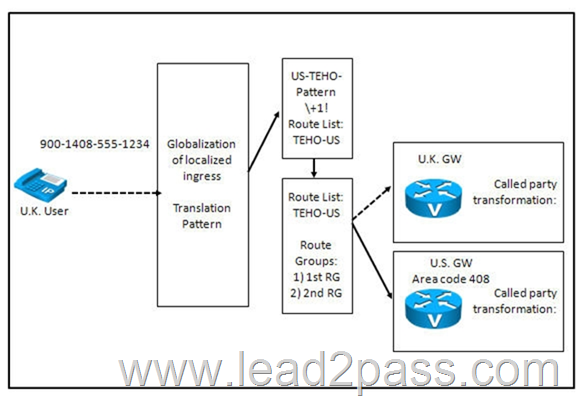
A. 9001.4085551234 with the Called Party Transformation:
Discard Digits PreDot
Prefix Digits Outgoing Calls: +
B. 9.0014085551234 with the Called Party Transformation:
Discard Digits PreDot
Prefix Digits Outgoing Calls: +1
C. 900.14085551234 with the Called Party Transformation:
Discard Digits PreDot
Prefix Digits Outgoing Calls: +1
D. 900.14085551234 with the Called Party Transformation:
Discard Digits PreDot
Prefix Digits Outgoing Calls: +
E. 001.4085551234 with the Called Party Transformation:
Prefix Digits Outgoing Calls: +
Answer: D
Explanation:
The PSTN access code for the UK is 9, International call code is 001, The international escape character, +, signifies the international access code in a complete E.164 number format.
QUESTION 198
Refer to the exhibit. The exhibit shows centralized Cisco Unified Communications Manager configuration components for TEHO calls to U.S. area code 408 from the U.K. The PSTN access code for the U.K. is 9 and 001 for international calls to the U.S. What should the TEHO-US route list configuration consist of?
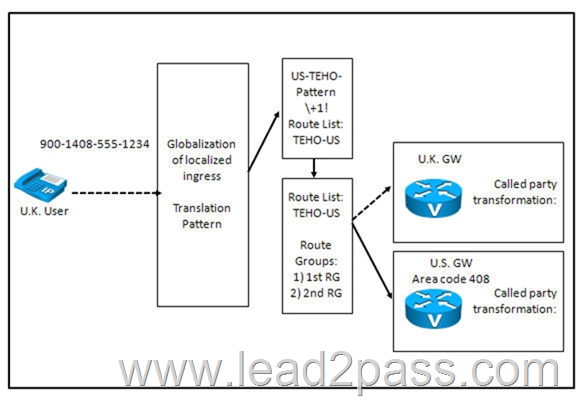
A. First route group should point only to the U.K. gateway.
The second route group should point to the U.S. gateway.
B. First route group should be only the local route group.
The second route group should point to the U.S. gateway.
C. First route group should point only to the U.S. gateway.
The second route group should be the local route group.
D. The TEHO-US route list should contain only the local route group.
The globalized configuration means that the appropriate gateway will be selected automatically.
E. The \+! route pattern should point directly to the U.S. gateway.
Answer: C
Explanation:
The route group points to one or more gateways and can choose the gateways for call routing based on preference. The route group can serve as a trunk group by directing all calls to the primary device and then using the secondary devices when the primary is unavailable. One or more route lists can point to the same route group.
QUESTION 199
Refer to the exhibit. The exhibit shows centralized Cisco Unified Communications Manager configuration components for TEHO calls to U.S. area code 408 from the U.K. The PSTN access code for the U.K. is 9 and 001 for international calls to the U.S. Assuming the PSTN does not accept globalized numbers with + prefix.
What should the Called Party Transformation Pattern at the U.S. gateway be configured as? 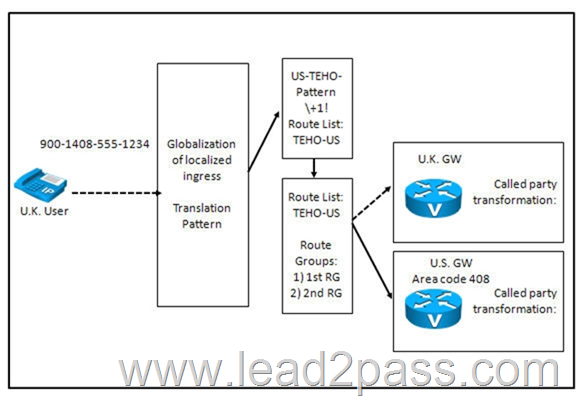
A. \+.! with the following Called Party Transformation:
Discard Digits PreDot
Prefix Digits Outgoing Calls: +
B. \+1.! with the following Called Party Transformation:
Discard Digits PreDot
Prefix Digits Outgoing Calls: None
C. \+408.! with the following Called Party Transformation:
Discard Digits PreDot
Prefix Digits Outgoing Calls: 1
D. \+1408.! with the following Called Party Transformation:
Discard Digits PreDot
Prefix Digits Outgoing Calls: None
E. \+1.408! with the following Called Party Transformation:
Discard Digits PreDot
Prefix Digits Outgoing Calls: None
Answer: D
QUESTION 200
Refer to the exhibit. The HQ site uses area code 650. The BR1 site uses area code 408. The long distance national code for PSTN dialing is 1. To make a long distance national call, an HQ or BR1 user dials access code 9, followed by 1, and then the 10-digit number. Both sites use MGCP gateways. AAR must use globalized call routing using a single route pattern. Assume that all outgoing PSTN numbers are localized at the egress gateway as shown in the exhibit.
What should the AAR group prefix be?
A. 9
B. 91
C. none
D. +
E. +1
Answer: C
Lead2pass is one of the leading exam preparation material providers. We have a complete range of exams offered by the top vendors. You can download 300-075 dumps in PDF format on Lead2pass.com. Comparing with others’, our 300-075 exam questions are more authoritative and complete. What’s more, the 300-075 dumps are the latest. We ensure you pass the 300-075 exam easily.
300-075 new questions on Google Drive: https://drive.google.com/open?id=0B3Syig5i8gpDZi1ZVXhiQWtBSFU
2016 Cisco 300-075 exam dumps (All 356 Q&As) from Lead2pass:
http://www.lead2pass.com/300-075.html [100% Exam Pass Guaranteed]
